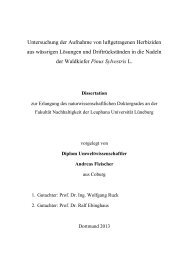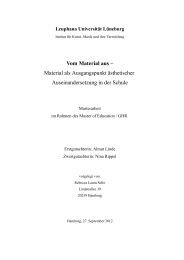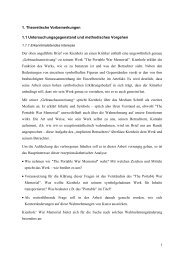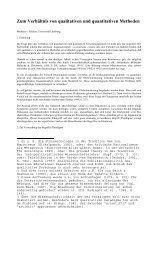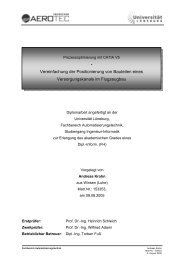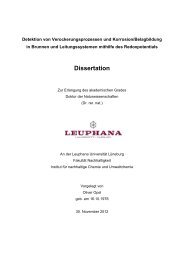Determinants of Emotional Experiences in Traffic Situations ... - OPUS
Determinants of Emotional Experiences in Traffic Situations ... - OPUS
Determinants of Emotional Experiences in Traffic Situations ... - OPUS
Create successful ePaper yourself
Turn your PDF publications into a flip-book with our unique Google optimized e-Paper software.
Introduc<strong>in</strong>g a Multivariate Model for Predict<strong>in</strong>g Driv<strong>in</strong>g Performance 101<br />
2004; Mesken, Lajunen & Summala, 2002) and driv<strong>in</strong>g motivation (Philippe, Vallerand, Richer,<br />
Vallières & Bergeron, 2009) can also lead to similar driv<strong>in</strong>g patterns. To our knowledge there is no<br />
empirically tested model which comb<strong>in</strong>es those variables and reveals the <strong>in</strong>teraction and dist<strong>in</strong>ct<br />
impact <strong>of</strong> personal characteristics, driv<strong>in</strong>g related anger and key <strong>in</strong>dicators <strong>of</strong> safe driv<strong>in</strong>g<br />
performance. To create and validate such a model, two simulator studies were conducted. The core<br />
elements <strong>of</strong> our model are a) the impact <strong>of</strong> anger on key risky driv<strong>in</strong>g parameters (velocity, speed<strong>in</strong>g,<br />
longitud<strong>in</strong>al and lateral acceleration), b) the <strong>in</strong>fluence <strong>of</strong> personal characteristics on anger experiences<br />
<strong>in</strong> traffic situations and c) the impact <strong>of</strong> personal characteristics on maladaptive driv<strong>in</strong>g parameters<br />
<strong>in</strong>dependent <strong>of</strong> anger. The follow<strong>in</strong>g sections review the literature and show the key f<strong>in</strong>d<strong>in</strong>gs <strong>of</strong> the<br />
specific core components. The lack <strong>of</strong> any research which exam<strong>in</strong>es the <strong>in</strong>teraction <strong>of</strong> these elements<br />
underl<strong>in</strong>es the necessity for a coherent model<br />
Anger and Risky Driv<strong>in</strong>g<br />
Unlike emotional and hostile aggression <strong>in</strong> driv<strong>in</strong>g situations, which is fed by strong emotional states<br />
and focuses on harm<strong>in</strong>g other traffic participants (Sh<strong>in</strong>ar, 1998), risky driv<strong>in</strong>g patterns <strong>of</strong>ten lack<br />
accompany<strong>in</strong>g emotion or <strong>in</strong>tention to harm. Nonetheless, studies <strong>in</strong>dicate a consistent relationship<br />
between anger and specific risky driv<strong>in</strong>g behaviour <strong>in</strong> traffic (e.g., Dahlen & White, 2006;<br />
Deffenbacher et al., 2003). Most importantly it can <strong>in</strong>fluence an <strong>in</strong>crease <strong>in</strong> speed (Deffenbacher,<br />
Lynch, Oett<strong>in</strong>g & Y<strong>in</strong>gl<strong>in</strong>g, 2001; Matthews et al., 1998; Underwood, Chapman, Wright & Crundall,<br />
1999), traffic violations (Maxwell, Grant & Lipk<strong>in</strong>, 2005; Sümer, 2003) and more generic risky<br />
behaviour such as driv<strong>in</strong>g recklessly or act<strong>in</strong>g carelessly when other people are <strong>in</strong> the car<br />
(Deffenbacher et al., 2001). These behaviours can <strong>in</strong>crease the risk <strong>of</strong> crashes and endanger other road<br />
participants (Chliaoutakis et al., 2002; Deffenbacher et al., 2003; Underwood et al., 1999). Generally<br />
speak<strong>in</strong>g, there is a moderate relationship between anger and risky driv<strong>in</strong>g, which is most <strong>of</strong>ten<br />
described with broad behaviours (e.g. reckless or drunk driv<strong>in</strong>g) and less <strong>of</strong>ten <strong>in</strong> terms <strong>of</strong> the specific<br />
driv<strong>in</strong>g patterns. Therefore, real driv<strong>in</strong>g and simulator studies are necessary to assess driv<strong>in</strong>g<br />
parameters such as speed adequately (Matthews et al., 1998; Mesken et al., 2007). Stephens &<br />
Groeger (2009) added means and standard deviations <strong>of</strong> longitud<strong>in</strong>al and lateral acceleration, lateral<br />
position, steer<strong>in</strong>g wheel, throttle and brake <strong>in</strong>put to the predicted parameters. They revealed a<br />
consistent relationship between high anger levels and <strong>in</strong>creased values for most <strong>of</strong> those variables.<br />
Personal Characteristics and Anger<br />
To describe the factors <strong>in</strong>fluenc<strong>in</strong>g anger <strong>in</strong> traffic environments more precisely, the personal<br />
characteristics <strong>of</strong> the driver have to be taken <strong>in</strong>to account (Mesken, Lajunen & Summala, 2002).<br />
Driv<strong>in</strong>g experience measured <strong>in</strong> total or yearly mileage shows <strong>in</strong>consistent patterns as a predictor <strong>of</strong><br />
anger and is strongly dependent on gender (Lajunen & Parker, 2001). In a study by Björklund (2008)<br />
driv<strong>in</strong>g experience had an <strong>in</strong>fluence on driv<strong>in</strong>g anger levels <strong>in</strong> situations with reckless driv<strong>in</strong>g or direct<br />
hostility <strong>of</strong> others, but only for female participants. In male populations there was no effect altogether<br />
<strong>of</strong> mileage on the anger experienced (Björklund, 2008). The gender <strong>of</strong> the participants can <strong>in</strong>fluence<br />
!



